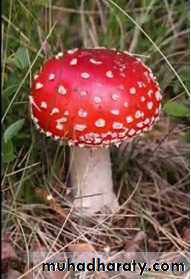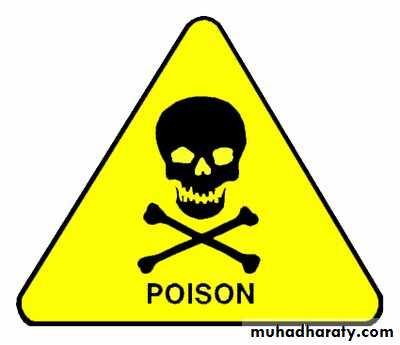Introduction to Toxicology
Toxicology:Is the study of adverse effect of external materials (Xenobiotics) on living organisms.
It is the study of symptoms, mechanisms, treatments and detection of poisoningThe recognition of toxicology is very ancient as people have always divided plants into:
-Safe plant-Harmful plant
Modern day toxicology had advanced so much because of the development of:
-Drugs.
-Industry.-Warfare…………….etc.
Toxicant: is a type of poison that is made by humans or introduced into the environment by human activity.
This is in contrast to a Toxin: which is a poison produced naturally by an organism (e.g. plant, animal, insect…etc.)
A Poison : Any substance capable of inducing deleterious response in a biological system:
-seriously injuring function-or causing death.
This definition is relatively broad and arbitrary!
An Antidote is a substance which can counteract a form of poisoning.
A specialist of internal medicine is making a routine morning tour :
1-Patient one had high fever, the order was:
Double the dose of “Fever Medication” toParacetamol tab. 2 X 3
2-Patient 2 was admitted for attempt of suicide by ingesting 20 tablets of Paracetamol:
The order was :Give Antidote to combat the effect of “The Poison”
In patient one Paracetamol was a useful medication.
Drug!In patient two the same drug was referred to as a Poison !
Why ?Paracelsus ( 1493-1541)
All substance are poison : there is non which is not a poison , the right dose differentiate a poison from a remedy!1-Accidental poisoning.
2-Suicidal poisoning.3-Iatrogenic poisoning.
4-Criminal poisoning.
5-Poisoning due to drug addiction.
Varieties of poisoning
Accidental poisoning:-Kerosene poisoning
-Pesticide poisoning (organophosphate)-Food poisoning.
-Carbon monoxide poisoning.
-Occupational poisoning (Ex. lead)
Drug poisoning
-Tricyclic antidepressants (TCA)-Other anti psychotics.
-Benzodiazepines.
-Anti epileptics.
-Analgesics NSAIs
Suicidal poisoning
Iatrogenic ( Induced by doctor)
-Poorly recognized-Under diagnosed.
-Drug interactions , over dosage, adverse reactions….etc.
Criminal Poisoning:
Least common?Heavy metals (arsenic).
Cyanide…etc.Drug addiction :
-Benzodiazepines.-Opiates (morphine , pethidine, tramadol).
-Anti Parkinsonian drugs (Procyclidine, Benzexhol).
-Alcohol.
Toxicology has three main fields:
1- Mechanistic toxicology.2- Descriptive toxicology.
3- Regulatory toxicology.Mechanistic toxicology
Is concerned with the:-molecular,
-cellular &-biochemical
basis of the actions of poisons.
(Mechanism of Action)
Descriptive toxicology:
Is concerned with signs and symptoms of poisoning, its effect on body functions & testing on biological systems. (Animal, Bacteria, …etc.)
Animal testing:
-Acute lethality. LD50 (less than 24 hours).-Skin and eye irritation (rabbit).
-Sensitization (delayed hypersensitivity reaction).
-Sub acute exposure (30 days).
-Sub chronic exposure ( 90 days).
-Chronic exposure (6 months).
Regulatory toxicology:
Is concerned with the use of the final results of mechanistic and descriptive toxicology in order to determine the Safety of various chemicals (Xenobiotics), and various other issues concerning their use including permitted concentrations.These regulations are enforced by Law.
Major branches of toxicology:
1-Medical/Clinical Toxicology.2-Enviromental Toxicology (Ecotoxicoloy).
3-Regulatory toxicology.
4-Analytical Toxicology.
5-Forensic Toxicology.
Spectrum of undesired effects:
1-Allergic reactions.2-Ideosyncritic reaction.
3-Immediat vs. Delayed reactions.
4-Reversable vs. Irreversible reaction.
5-Local vs. Systemic reaction.
Factors that determine the toxic effect:
1- Characteristic of exposure. Biotransformation
2-Route and site of exposure3-Duration and frequency of exposure .ex carcinogenic agents.
Characteristics of exposure:
-Rout and site of exposure.-Duration and frequency of exposure.
-Dose response relationship.
Individual differences in response:
It is very well known that there is a wide variation in individual response to exposure to a toxic chemical.Ex. Food poisoning may not affect all exposed people.
Redistribution.
Metabolism.
Excretion.Liver kidney….
Biotransformation of Xenobiotics:-Hydrolysis.
-Oxidation.-Reduction.
-Conjugation.
Developmental and reproductive toxicity.
Concerned with the effect of Xenobiotics one organ development during the whole life span of the individual.Mutagenicity, Toxicogenomics.
The ability of a Xenobiotics to induce changes in the DNA:
(DNA Mutation)
Developmental toxicity:
Development of organs at any stage of life.Teratogenicity :
From conception to birth
((Congenital Malformations))
Mutagenicity:
Ability to cause changes in genetic material.((Carcinogenicity))
Classification of toxic agents:
1-According to the Target Site ex. Liver, kidney, CNS….etc.
2-According to Use ex. Pesticide, Food Additives …..etc.
3-According to the Effect. ex Carcinogenic Irritant, Corrosive…..etc.
4-According to the Physical State ex. gas liquid..
5-According to general Chemical Structure.
Selective toxicity:
Capability of injuring one kind of living organisms without injuring other living system even if the two were co-existent.Tolerance:
Decreased response to toxic effect after repeated exposure.How Xenobiotics affect function:
1- Bind and damage Protein (Structure or enzyme).2- Bind and damage the DNA.
3- Bind and damage Lipids.
4-React in the cells with oxygen free radicals. (Lipid & DNA damage).
Biological samples in toxicology:
1-Blood samples ( serum or plasma)
2-Urine samples.
In forensic settings:
-tissues samples.-gastric content analysis.
-hair and nail samples ( heavy metals)
-blood samples & urine.
Important notes on clinical samples:
1- Proper separation of RBCs ( centrifugation ).2-Use deep freezing of stored plasma and serum if the analysis is delayed.
3- Withdraw the proper amount of blood when needed (10 ml if not sure).In forensic samples always
pay attention to what iscalled the:


















